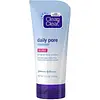What's inside
What's inside
 Key Ingredients
Key Ingredients

No key ingredients
 Benefits
Benefits

 Concerns
Concerns

 Ingredients Side-by-side
Ingredients Side-by-side

Water
Skin ConditioningCocamidopropyl Betaine
CleansingSodium Laureth Sulfate
CleansingAcrylates Copolymer
PEG-80 Sorbitan Laurate
Coco-Glucoside
CleansingDi-PPG-2 Myreth-10 Adipate
EmollientGlyceryl Oleate
EmollientGlycerin
HumectantParfum
MaskingDMDM Hydantoin
PreservativeSoyamidopropyl Betaine
CleansingLauryl Methyl Gluceth-10 Hydroxypropyldimonium Chloride
Methylparaben
PreservativeTetrasodium EDTA
Sodium Hydroxide
BufferingPolyquaternium-10
Butylene Glycol
HumectantSilica
AbrasivePEG-16 Soy Sterol
EmulsifyingGlycine Soja Protein
EmulsifyingCitric Acid
BufferingMica
Cosmetic ColorantTitanium Dioxide
Cosmetic ColorantWater, Cocamidopropyl Betaine, Sodium Laureth Sulfate, Acrylates Copolymer, PEG-80 Sorbitan Laurate, Coco-Glucoside, Di-PPG-2 Myreth-10 Adipate, Glyceryl Oleate, Glycerin, Parfum, DMDM Hydantoin, Soyamidopropyl Betaine, Lauryl Methyl Gluceth-10 Hydroxypropyldimonium Chloride, Methylparaben, Tetrasodium EDTA, Sodium Hydroxide, Polyquaternium-10, Butylene Glycol, Silica, PEG-16 Soy Sterol, Glycine Soja Protein, Citric Acid, Mica, Titanium Dioxide
Water
Skin ConditioningPropylene Glycol
HumectantSodium Laureth Sulfate
CleansingCocamidopropyl Betaine
CleansingJojoba Esters
EmollientSodium Lauroamphoacetate
CleansingDisodium Lauroamphodiacetate
CleansingLauryl Methyl Gluceth-10 Hydroxypropyldimonium Chloride
Sodium Carbomer
Emulsion StabilisingGlycol Distearate
EmollientPEG-120 Methyl Glucose Dioleate
EmulsifyingLaureth-4
EmulsifyingLactic Acid
BufferingParfum
MaskingTetrasodium EDTA
Polysorbate 20
EmulsifyingMethylchloroisothiazolinone
PreservativeMethylisothiazolinone
PreservativeWater, Propylene Glycol, Sodium Laureth Sulfate, Cocamidopropyl Betaine, Jojoba Esters, Sodium Lauroamphoacetate, Disodium Lauroamphodiacetate, Lauryl Methyl Gluceth-10 Hydroxypropyldimonium Chloride, Sodium Carbomer, Glycol Distearate, PEG-120 Methyl Glucose Dioleate, Laureth-4, Lactic Acid, Parfum, Tetrasodium EDTA, Polysorbate 20, Methylchloroisothiazolinone, Methylisothiazolinone
 Reviews
Reviews

Ingredients Explained
These ingredients are found in both products.
Ingredients higher up in an ingredient list are typically present in a larger amount.
Cocamidopropyl Betaine is a fatty acid created by mixing similar compounds in coconut oil and dimethylaminopropylamine, a compound with two amino groups.
This ingredient is a surfactant and cleanser. It helps gather the dirt, pollutants, and other impurities in your skin to be washed away. It also helps thicken a product and make the texture more creamy.
Being created from coconut oil means Cocamidopropyl Betaine is hydrating for the skin.
While Cocamidopropyl Betaine was believed to be an allergen, a study from 2012 disproved this. It found two compounds in unpure Cocamidopropyl Betaine to be the irritants: aminoamide and 3-dimethylaminopropylamine. High-grade and pure Cocamidopropyl Betaine did not induce allergic reactions during this study.
Learn more about Cocamidopropyl BetaineWe don't have a description for Lauryl Methyl Gluceth-10 Hydroxypropyldimonium Chloride yet.
Parfum is a catch-all term for an ingredient or more that is used to give a scent to products.
Also called "fragrance", this ingredient can be a blend of hundreds of chemicals or plant oils. This means every product with "fragrance" or "parfum" in the ingredients list is a different mixture.
For instance, Habanolide is a proprietary trade name for a specific aroma chemical. When used as a fragrance ingredient in cosmetics, most aroma chemicals fall under the broad labeling category of “FRAGRANCE” or “PARFUM” according to EU and US regulations.
The term 'parfum' or 'fragrance' is not regulated in many countries. In many cases, it is up to the brand to define this term.
For instance, many brands choose to label themselves as "fragrance-free" because they are not using synthetic fragrances. However, their products may still contain ingredients such as essential oils that are considered a fragrance by INCI standards.
One example is Calendula flower extract. Calendula is an essential oil that still imparts a scent or 'fragrance'.
Depending on the blend, the ingredients in the mixture can cause allergies and sensitivities on the skin. Some ingredients that are known EU allergens include linalool and citronellol.
Parfum can also be used to mask or cover an unpleasant scent.
The bottom line is: not all fragrances/parfum/ingredients are created equally. If you are worried about fragrances, we recommend taking a closer look at an ingredient. And of course, we always recommend speaking with a professional.
Learn more about ParfumSodium Laureth Sulfate (SLES) is a foaming, cleansing, and emulsifying ingredient. It is created from palm kernel oil or coconut oil. SLES is not the same as sodium lauryl sulfate. It is much milder and less likely to irritate.
SLES helps create foam in personal products. It also prevents ingredients from separating, helping to elongate the shelf life.
Sodium Laureth Sulfate is a type of sulfate. It can be drying. We recommend speaking with a professional about using this ingredient if you have concerns.
Learn more about Sodium Laureth SulfateTetrasodium EDTA is the salt formed from neutralizing ethylenediamine tetraacetic acid with sodium hydroxide. It is a chelating agent and used to prevent metal ions from binding to other ingredients. This helps keep the product and ingredients stable.
Tetrasodium EDTA comes as a white solid and is soluble in water.
Water. It's the most common cosmetic ingredient of all. You'll usually see it at the top of ingredient lists, meaning that it makes up the largest part of the product.
So why is it so popular? Water most often acts as a solvent - this means that it helps dissolve other ingredients into the formulation.
You'll also recognize water as that liquid we all need to stay alive. If you see this, drink a glass of water. Stay hydrated!
Learn more about Water